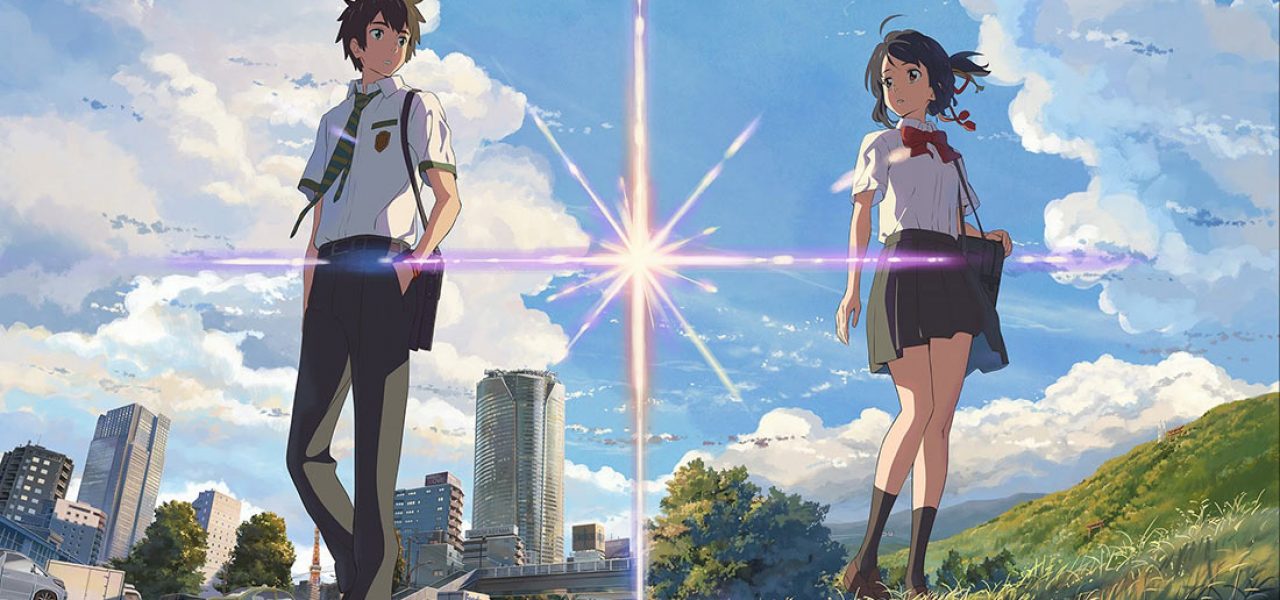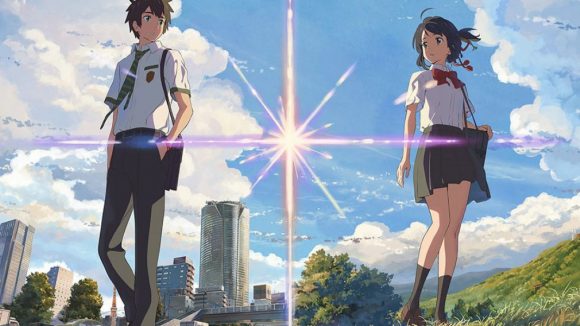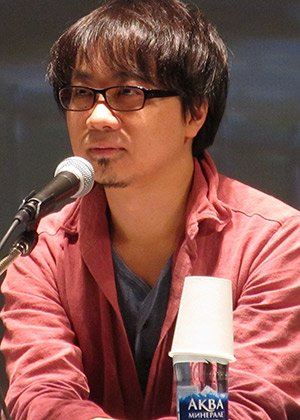

Makoto Shinkai At 50: A Career Retrospective
Makoto Shinkai turned 50 today and to celebrate the occasion we’re looking back at one of the most important filmmaking careers in the history of Japanese animation.
Early Career

Following a stint as a graphic designer at the Nihon Falcom video game company, Shinkai struck out on his own making several independently produced projects that he wrote, directed, and produced, as well as provided vocal performances. As Shinkai’s projects have grown in scale and profile, on a historical scale, that sense of control and very close personal involvement has remained. His aesthetic quirks, his penchant for lavish photorealistic background art, and his equally lush lighting have only improved over time
Throughout his career, Shinkai has been referred to as the “Next Miyazaki,” a term perhaps too readily thrown around following the release of Your Name, especially after the film shattered Japanese box office records. Shinkai shied away from the label, describing it as a superficial term, a measure of box office return more than anything.
Today, the visual language of Shinkai’s work is very firmly his own, and one can track the evolution of his visual and narrative interests throughout his illustrious career. Elements at the forefront of his early short Voices of a Distant Star are still present. And with his latest film Suzume being the first anime film playing the Berlinale competition in over 20 years, the public and critical popularity he has gained over the years show no signs of plateauing.
Now, let’s look back at some of Shinkai’s standout work. This list is in no way comprehensive but rather meant to track the aesthetic evolution of one of Japan’s greatest filmmakers.
Voices of a Distant Star (2004)
The original video animation (OVA) Voices of a Distant Star is probably best remembered for its mostly DIY assembly. Shinkai serves as its sole animator as well as writer, director, and producer (not to mention that Shinkai and his girlfriend at the time, Mika Shinohara, provide the voices in the first Japanese dub).
Though partially set on Mars in the year 2047, the tone and scenery of Voices’ opening scene make it feel like it takes place in, well, 2004. The characters even have flip phones. Though Gunbuster-lite, robot-versus-alien action is part of the narrative’s main thrust the focus lies in the pain of a long-distance relationship, with complications from time dilation thrown in for good measure. With heavier genre elements and the film’s tempo and story focus, much of the OVA feels like a rough draft that would be iterated upon in later works. Primarily animated in cg, thanks to software available at Shinkai’s old workplace Falcom, the mix of digital animation, hyperreal painted backgrounds, and simple character drawings feels like an onscreen representation of the director having a foot in different aesthetic worlds.
5 Centimeters Per Second (2007)
To this point, 5 Centimeters Per Second stands out among Shinkai’s filmography not just for its larger production team, but for how it keeps both feet firmly in reality. 5 Centimeters is driven purely by yearning. Though it’s broken down into an anthology structure, it tells the story of one boy, Takaki, and three distinct events from different periods of his life. Separated from his childhood love Akari, the boy suffers from an emotional wound that festers with time.
The first episode, “Cherry Blossoms,” introduces the pair before quickly breaking them apart. It then retraces their correspondence and a brief, bittersweet reunion. The second, “Cosmonaut,” switches to a more alienating perspective, viewing Takaki through the eyes of his friend Kanae who secretly pines for him. The final, shortest episode sees Takaki’s feelings evolve into an adult malaise in a vibe that’s familiar to anyone who starts their Shinkai education with his later work. 5 Centimeters Per Second feels a lot like the bedrock for the teen romances that Shinkai is now known best for.
The character work isn’t hugely complicated; the focus instead is on creating mood. If there’s any one thing that consistently stands out in Shinkai’s films it’s the lighting. No matter how busy every frame gets with details, the color and tone of the light becomes the focus. Oscillating between distant cold and nostalgic warmth, the light is always in tune with Takaki’s melancholy or rose-tinted views of the past, Kanae’s admiration of him, or the isolation of a big city. 5 Centimeters was an early hit for Shinkai, one of a handful of “bummer” movies from his filmography that fully weaponizes his craft.
The Garden of Words (2013)
Memory, preservation, and remembrance are key to Shinkai’s films. His motivation for the scenery in The Garden of Words seems to reveal a general approach to background art; if he loved a place and feared its erasure, he drew it. The earthquake of March 2011 made a beloved park feel ephemeral – much like the relationships he portrays in the film. The construction of his backgrounds both before and after Garden – vivid, specific detail drawn over the base of a photograph – isn’t a completely idiosyncratic practice, but its use here feels more pointed through this lens.
Every scene feels like a commitment to memory, recreating the sensations of a place. The way light reflects and refracts through spaces evokes a sense of nostalgic recollection. The beatific scenery and the sound of wind and raindrops are all emblematic of the refuge the protagonist Takao finds in the park versus the overstimulation of the city.
It feels like a codifying of various, more specific Shinkai obsessions that one can see threaded throughout his work – Waka poetry (in this film invoked through the Man’yōshū collection) in particular as an inspiration, alongside the usual melancholic train journeys, shots of birds in flight, and stories of urban malaise. But The Garden of Words also switches up his style in compelling ways. The more detail-intensive backgrounds at one stage fade to patchy watercolor or a grainy emulation of video; the film overall switches to cooler color tones over vivid sunset glows. Amidst this atmosphere the teenager Takao and the 27-year-old Yukari meet by chance in a park in the rain, the former ditching school and drawing shoe designs and the latter in absentia from work, reading a collection of poems. The meetings become regular, whenever it rains.
“To me, she represents nothing less than the very secrets of the world” – Takao dramatically ponders. The film slowly but surely becomes about deconstructing the mystique around the working adult, also out of control of their own lives. To Takao, Yukari’s isolation in the park seems like the promise of a more liberated future. Yukari wonders if it’s too late for her to change her own life, losing her taste for it.
The relationship is more boyish crush than mutual romance, though it walks a rather taboo line in a lavishly drawn and tender sequence of Takao measuring Yukari’s feet for shoes. That striking and perhaps mildly fetishistic moment aside, it’s more about the intense and unlikely connection between two lonely people that changed the trajectory of their lives; fleeting, but they’ll always remember it.
Your Name (2016)
The biggest film of not just Shinkai’s career but one of the highest profile anime features full stop, Your Name is probably the greatest distillation of the director’s appeal. It’s a ruthlessly sincere approach to teenage melodrama with a dash of the supernatural and spirituality. Lavish art direction full of warm light and expansive skies rivals the drama of the romance at the film’s center. It’s not without levity, however. Your Name finds a lot of juvenile amusement in its premise: Taki and Mitsuha – a boy from the city and a girl from the countryside – periodically swap bodies, walking days in the other’s shoes and making goofy mishaps as they adjust to urban or rural life. Outside of its sci-fi fantasy twist, it quotes 5 Centimeters and The Garden of Words almost verbatim at times – but as the saying goes, if it ain’t broke.
The film’s incredible success overwhelmed Shinkai, who has said on record, although perhaps tongue-in-cheek, “it’s not healthy.” Your Name went on to become the third-highest-grossing anime film of all time and is getting a live-action, English-language remake from Bad Robot.
Your Name is constantly on the verge of feeling overcooked. Swelling, guitar-laden songs by Radwimps contribute to the sensation, but its continual, giddy transformation and escalation are also remarkable. It’s not just a body swap rom-com, but also a movie about love in the form of memory as well as love measured against the end times. Amongst the film’s wacky slapstick, it’s also revealed that a comet is about to hit Mitsuha’s hometown, an event Shinkai says is partially inspired by the 2011 earthquake, like The Garden of Words before it. That’s still not quite all Your Name has hidden up its sleeve, but for any reader interested in Shinkai’s work who hasn’t seen it yet, I’ll save the breathless description of how it continually pushes things to another level.
With animation direction by Masashi Ando (who would later co-direct The Deer King) and character design by Masayoshi Tanaka, the gap between the more simply drawn characters and the overwhelming detail of the background art feels just a little bit narrower, with more involved expression through the acting. But it’s also capable of more serene and even existential beauty. A late film sequence suddenly does away with its obsessive photorealism for a more flowing, expressive animation style of constantly morphing shapes.
Weathering With You (2019)
Weathering With You is, perhaps, the first time that Shinkai’s work has demonstrated a level of diminishing returns on recurring thematic materials. It’s also a film that more officially codifies the filmmaker’s visual style. A teenage romance set against an apocalyptic backdrop, with intervention from religious belief and strange magic power, there’s a fair bit of overlap between his 2016 smash hit and this equally bombastic young adult rom-com.
Weathering with You is fuelled by a fair bit of climate anxiety: even the rain is designed to be “violent and aggressive”, as well as this changing perspective on human co-existence with nature. The film is an incredibly literal culmination of Shinkai’s interest in rituals, whether personal or traditional, as a way to put the world in order and exert a sense of control over it – whether that’s meetings in a park to draw some shoe designs or a teenage business venture around magic weather manipulation.
Alongside some rather funny product placement, (McDonald’s is a plot point), Weathering With You can feel too familiar at times, but even when Shinkai’s films are on autopilot they’ve still got the goods. If nothing else, it’s simply wonderful to look at.
Perhaps with Weathering You Shinkai’s reflections on what he didn’t have time to fully accomplish in Your Name shine through. Perhaps the film is intended as another thematic side to the same coin. If the connection between the films wasn’t evident enough, cameos from multiple Your Name characters solidify the notion. Either way, it’s a nice bookend to what he started with The Garden of Words, a film equally obsessive over the rainy season as an excuse for its main characters to meet with each other. This time, though,Weathering With You is all about clearing the skies, doing away with the intense melancholy of earlier work with some rather wild wish fulfillment.

.png)